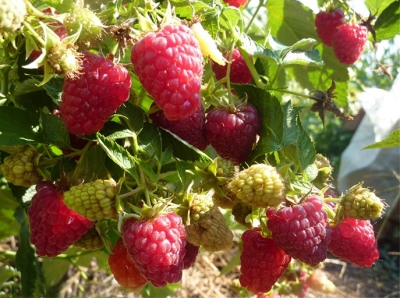
- Repairability: Yes
- Berry color: ruby
- Taste: sweet and sour, dessert
- Berry weight, g: no more than 3.5-4
- Yield: 2.1-2.6 kg per bush
- Frost resistance: high
- Appointment: universal
- Fruiting period: from early August to frost
- Watering: moderate
- Pruning: in the fall, remove the aerial part of the bush
Raspberries can be seen on every household plot, but gardeners are trying to plant a non-capricious variety with good taste. These include the raspberry variety Indian Summer 2.
Breeding history of the variety
The large-fruited raspberry Indian Summer 2 was bred by Russian breeders led by Kozakov. Various varieties were used for crossing, along with the main one - Indian Summer.
Description of the variety
This remontant variety of raspberries is characterized by early ripening of berries, resistance to weather fluctuations, and the ability to grow on any type of soil. A medium-sized plant with erect shoots and many sharp thorns, prone to rapid growth.
Ripening terms
The ripening period depends on the climatic conditions. Flowering falls in June, and the first raspberries appear in early August, and it bears fruit until the very cold. It is important that the berry does not crumble or spoil.
Growing regions
The plant grows well in almost any region, since it is characterized by frost resistance, it tolerates heat well. In regions with a scorching sun and a lack of rain, it is enough to provide a high-quality irrigation system. Today this variety of raspberries is grown on the territory of Russia, Belarus, Ukraine.
Yield
The yield indicators of the variety are quite high. On average, you can collect from 2 to 3 kg of berries from a bush. It is characteristic that the crop is harvested from the first year.
Berries and their taste
Raspberry fruits Indian Summer 2 have a conical shape, medium size (fruit weight 3.5-4 grams), glossy surface and incredibly beautiful color - dark ruby. The berry has a rich, sweet-sour taste. The structure of the fruit is dense and fleshy, which guarantees high-quality transportation, while maintaining its presentation. Raspberries are eaten fresh, frozen and canned. In addition, the juiciness and meatiness of the berry allows you to add it to pies and other baked goods.

Growing features
The plant has its own characteristics of cultivation and care, observing which you can get an excellent harvest.
Site selection and soil preparation
The plant prefers fertile and fertilized soil that is well hydrated and breathable. The site must be sunny and protected from wind and drafts. It is not recommended to plant the plant in lowlands where groundwater flows close. The place must be cleared of weeds and carefully dug up. In addition, raspberries can grow well in urban conditions, absolutely adapting to gas pollution and smoke. Planting a plant is possible both in autumn and spring.


Pruning
Timely pruning is an important element of caring for Indian Summer 2 raspberries. The stems are pruned in late autumn. Shortening involves removing the entire aerial part of the bush. Dried and dead branches are pruned in early spring. Root growth is also destroyed.

Watering and feeding
This type of plant needs regular and moderate watering, especially for young bushes. The root system of raspberry Indian Summer 2 is on the surface, so it dries up quickly, and to prevent this from happening, you should regularly fluff the soil and water. The berry is usually watered once a week.
Do not forget about the introduction of nitrogen-containing fertilizers, which can positively affect the abundance of the crop. The root and foliar systems should be fed.


Frost resistance and preparation for winter
The raspberry variety is very frost-resistant, but at a temperature of -20 ... 30 degrees, it is necessary to insulate the culture with agrofibre. Shelter is necessary during winters with little snow.

Diseases and pests
The variety is resistant to diseases and pests, but preventive measures should be followed. As a preventive measure, spraying with special solutions is suitable.

Unfortunately, raspberries, like other plants, do not bypass various diseases and pests. Only armed with the knowledge and the necessary means for this, you can cope with such troubles. To help the plant, it is very important to be able to recognize the disease in time and begin timely treatment.
Reproduction
The plant propagates by means of root suckers. For this, young shoots up to 15-20 cm in height are separated and buried in the ground. The best time for this is May-June. If the procedure is followed correctly, then the next year you can harvest berries.

Review overview
This remontant variety is in great demand among amateur summer residents and farmers who grow berries on an industrial scale, since Indian Summer 2 raspberries are sweet, fleshy, aromatic, with high yield and preservation rates.
Among the advantages of the variety are also noted unpretentiousness in care, adaptation to different types of soil, as well as the ability to enjoy fresh berries even in late autumn. The disadvantages of the variety include spreading roots, as well as regular monitoring of soil moisture.







































































